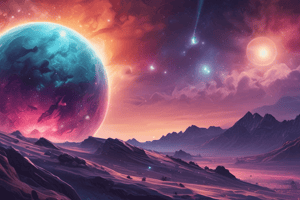Podcast
Questions and Answers
How do neutron stars form?
How do neutron stars form?
When a star with a mass of 8 times to 20 times that of the Sun dies, it ejects its matter into space in a supernova. A core is left behind that has a mass of about 1.4 times that of the Sun.
What are neutron stars composed of?
What are neutron stars composed of?
A core of mostly neutrons with some free protons and electrons, and a crust of highly-compressed regular matter.
How were the neutrons formed?
How were the neutrons formed?
The density of the core after a supernova has such strong gravity that it smashed protons and electrons together, forming neutrons.
What do astronomers call all of the material that makes up a neutron star?
What do astronomers call all of the material that makes up a neutron star?
What is the diameter of a neutron star?
What is the diameter of a neutron star?
How strong is the gravity of a neutron star?
How strong is the gravity of a neutron star?
What would happen to a human on the surface of a neutron star?
What would happen to a human on the surface of a neutron star?
How does a neutron star rotate?
How does a neutron star rotate?
What does the rapid rotation of a neutron star create?
What does the rapid rotation of a neutron star create?
What are pulsars?
What are pulsars?
Are all neutron stars pulsars?
Are all neutron stars pulsars?
What are magnetars?
What are magnetars?
Flashcards are hidden until you start studying
Study Notes
Formation of Neutron Stars
- Neutron stars form from the remnants of stars with masses between 8 to 20 times that of the Sun after a supernova explosion.
- Following the explosion, a core remains with a mass approximately 1.4 times that of the Sun.
Composition of Neutron Stars
- The core primarily consists of neutrons, along with some free protons and electrons.
- A crust of highly-compressed conventional matter exists above the core.
Formation of Neutrons
- Intense gravitational forces in the core post-supernova lead to the merging of protons and electrons, resulting in neutron formation.
Neutronium
- The material that composes a neutron star is referred to as neutronium.
Size of Neutron Stars
- Neutron stars typically have a diameter of about 20 kilometers.
Gravitational Strength
- The gravity on the surface of a neutron star is approximately 100 billion times stronger than that of Earth.
Effects on Humans
- A human placed on the surface of a neutron star would be compressed to a thickness of just a few atoms and would weigh hundreds of trillions of pounds.
Rotation of Neutron Stars
- Neutron stars rotate rapidly due to their extreme density, which enhances centrifugal forces similar to an ice skater spinning.
Magnetic Field Generation
- The rapid rotation of neutron stars creates a strong magnetic field.
Pulsars
- Pulsars are neutron stars emitting rotating beams of light energy, which are detectable at regular intervals by observers on Earth.
Not All Neutron Stars are Pulsars
- While all neutron stars emit beams of light, only those with beams aligned towards Earth are classified as pulsars.
Magnetars
- Magnetars are a type of neutron star distinguished by their extraordinarily strong magnetic fields, making them the most magnetic entities in the universe.
Studying That Suits You
Use AI to generate personalized quizzes and flashcards to suit your learning preferences.




